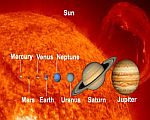- Home
- The Big Bang
The Big Bang - how the Universe came into existence?
It is generally believed that the Universe has not always existed, but actually had a beginning. The Big Bang theory is an attempt to explain what happened at that point in the past, before which there was nothing.
"Nothing", in the previous sentence, actually means what it says: prior to the Universe springing into existence, there was no space, no time...nothing. Why a complete Universe should suddenly be created from this nothingness is not known and this has led to speculation about whether it was an act of God. The Big Bang is where science meets religion.
Believe it or not, lots of things happened before the Universe was just one second old.
The Planck Epoch
Approximately 13.7 billion years ago, the Universe suddenly popped into existence from nothing. Initially, it was an infinitely hot and infinitely dense point.
It is thought that the four fundamental forces of the Universe (gravity, the electromagnetic force, the weak nuclear force and the strong nuclear force) were unified at this time into one universal force.
This "epoch" lasted just one Planck Time Unit (the smallest unit of time possible - one thousand million million million million million million millionths of a second), at the end of which the Universe was one Planck length across. It still contained all of the ingredients required to make the Universe as it is today.
The Grand Unification Epoch
It's slightly a misnomer calling these periods "epochs", as this one lasts just one sixth of a second. During this time in the still microscopic Universe, the force of gravity separates itself from the other three fundamental forces.
From its original unbelievably high temperature, the Universe is starting to cool, allowing the creation of elementary particles and anti-particles.
Also, at the end of this brief epoch, the strong nuclear force also separates, heralding the start of the next epoch.
Inflationary Epoch
The duration of this epoch is a little uncertain, but may be as brief as one thirteenth of a second. The separation of the strong nuclear force causes the microscopic Universe to expand by a factor of 100 million million million million. Believe it or not, after that, it is still only around four inches across! Thereafter, it continues to expand at a rate faster than the speed of light. (This doesn't violate the rule that nothing can travel faster than light, because it is space itself that is expanding.)
Electroweak Epoch
This begins at the same time as the Inflationary Epoch, but lasts almost a full half second. By now, the Universe has cooled to 10,000 million million million million degrees Kelvin, allowing for the creation of so-called "exotic" particles. These are largely theoretical and are thought to display very unusual properties. W and Z bosons appear, whose function is to control the weak nuclear force. Also, at this time, the Higgs field comes into play. This is a theoretical energy force that imparts mass to these bosons, thus turning a Universe consisting totally of radiation into one that can accommodate matter - the stars and galaxies of the future.
Quark Epoch
This epoch lasts around one seventh of a second and, by now, the Universe has cooled to a mere 10 million million million million degrees. Large numbers of quarks, electrons and neutrinos are formed, each with their equivalent anti-particle. Despite the previous action of the Higgs field, imparting mass to certain particles, the creation of matter from this is hampered by the fact that particles and anti-particles annihilate each other on contact. But, obviously, matter was created - it's what you're made of after all - and it is thought that, for some mysterious, unknown reason, there were, at this time, a few more baryons than antibaryons. It was only of the order of three per million, but sufficient to make matter creation possible.
Hadron Epoch
It's amazing to think that we've not yet reached one second after the Big Bang! This milestone is reached by this epoch and it is of a similar duration to the previous one. By now, the temperature of the Universe has cooled to around one trillion degrees, allowing quarks to combine to form hadrons. This is a collective name for such particles as protons. Free electrons collide with them and form neutrons. The Universe, by this time, has expanded to around 625 million million miles across.
Lepton Epoch
Compared to conditions and activity during the first second after the Big Bang, things now start to quieten down a bit. This epoch lasts a full three minutes! The cooler the Universe gets, the more complex elementary particles are allowed to form. By now, all hadrons and anti-hadrons from the previous epoch have annihilated each other, leaving the Universe full of leptons (electrons and positrons). These particles then collide and annihilate each other, resulting in energy being released as photons of light.
Nucleosynthesis
A 17 minute epoch, where the temperature has dropped further to one billion degrees. This allows for nuclear fusion to take place, whereby protons and neutrons combine to form the nuclei of simple elements such as hydrogen, helium and lithium. This epoch ends as the temperature drops to a point where nuclear fusion ceases to be possible.
Photon Epoch
Beginning at the same time as the previous epoch, this is a little different as it lasts for some 240,000 years! This large time span allows for the Universe to cool considerably. Its contents by this time consist of a sort of plasma made up of the atomic nuclei formed in the nucleosynthesis period and free electrons. While the dominant energy at this time is the photon, it is still tied to these other elementary particles, interacting with them continuously.
Recombination
This period lasts around 60,000 years and, by now, the Universe has cooled to only 3,000 degrees. The atomic nuclei now combine with the free electrons to form the elements hydrogen, helium and lithium. This action neutralises the electrons' electric charge, which, in turn, frees the photons of light. This means that these photons should be now detectable by apparatus on Earth and, indeed, they have been discovered, in the shape of Cosmic Background Radiation. Currently the Universe consists of three-quarters hydrogen atoms, nearly one-quarter helium and traces of lithium.
Dark Era
For the next 150 million years the Universe is in this "dark" state. Although photons are present, they are only detectable as radiation, rather than actual light. Nothing much happens during this period, except continuous expansion and cooling. This period seems to be dominated by the mysterious "dark matter".
Reionization
Finally, about 150 million years after the Big Bang, things start to happen again. Gravitational collapse causes quasars to form. These, in turn, reionize the surrounding Universe. This period lasts until about one billion years after the Big Bang and sets the scene for the formation of stars and galaxies.
Stelliferous Era
From around 300 million years after the Big Bang, conditions are favourable for the creation of the first stars. The plasma soup that permeates the Universe displays slight irregularities in density, so gravity seizes on this, drawing the cosmic gas clouds together. As they become more and more dense, a point is reached where nuclear fusion becomes possible. This gives birth to the very first stars, red giants known as "Population III" stars. This simply means that they are "metal free" - in other words, made of light elements. These are very short-lived and end their lives as supernovae, in the process creating and spreading heavier elements throughout the Universe. The presence of these elements, such as carbon, nitrogen, oxygen, silicon, magnesium and iron, pave the way for the birth of more mainstream stars. As more and more are created, they clump together to form galaxies. About 500 million years after the Big Bang, the Universe finally gives off light and becomes visible.









Facebook Comments
Have your say about what you just read! Leave me a comment in the box below.